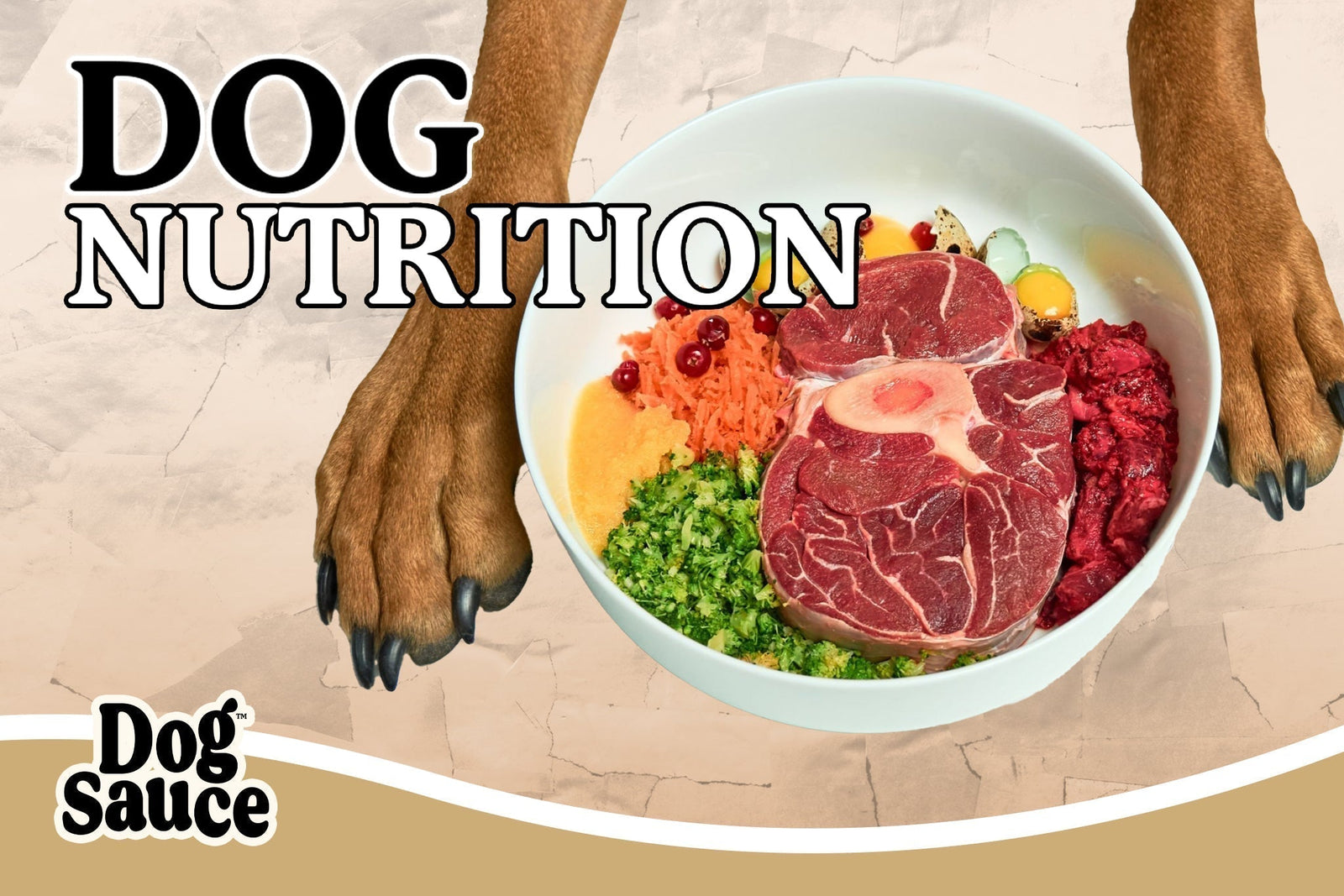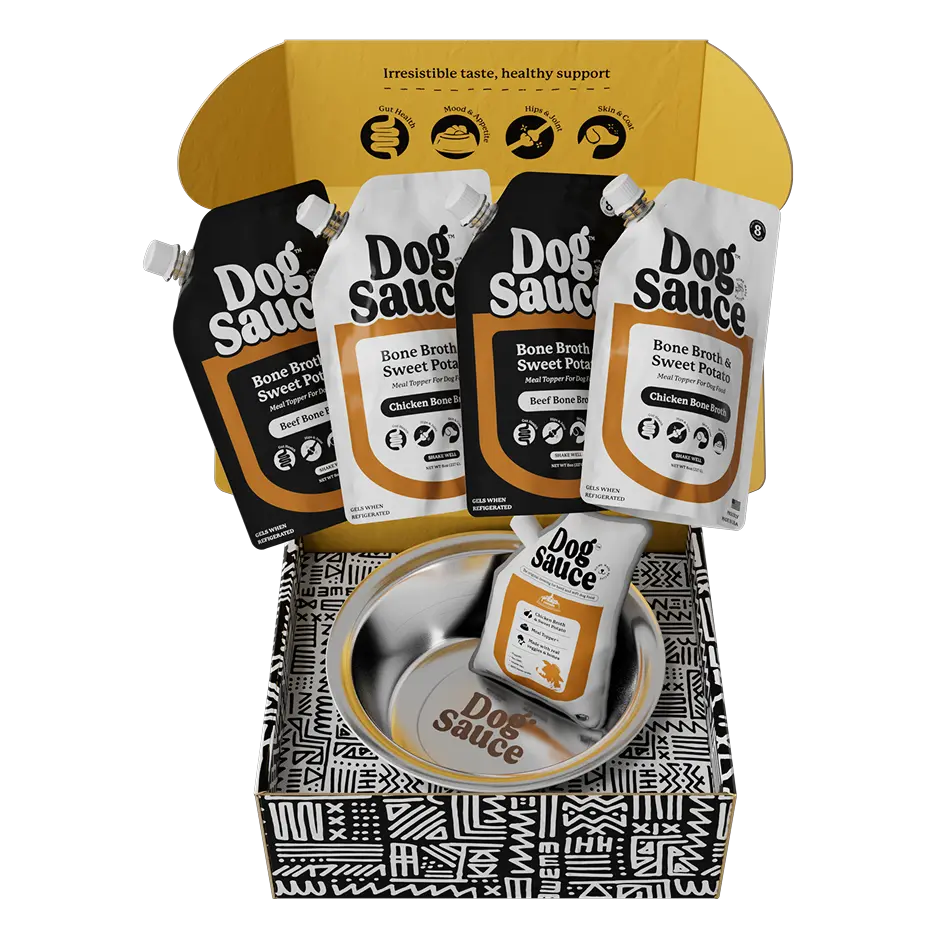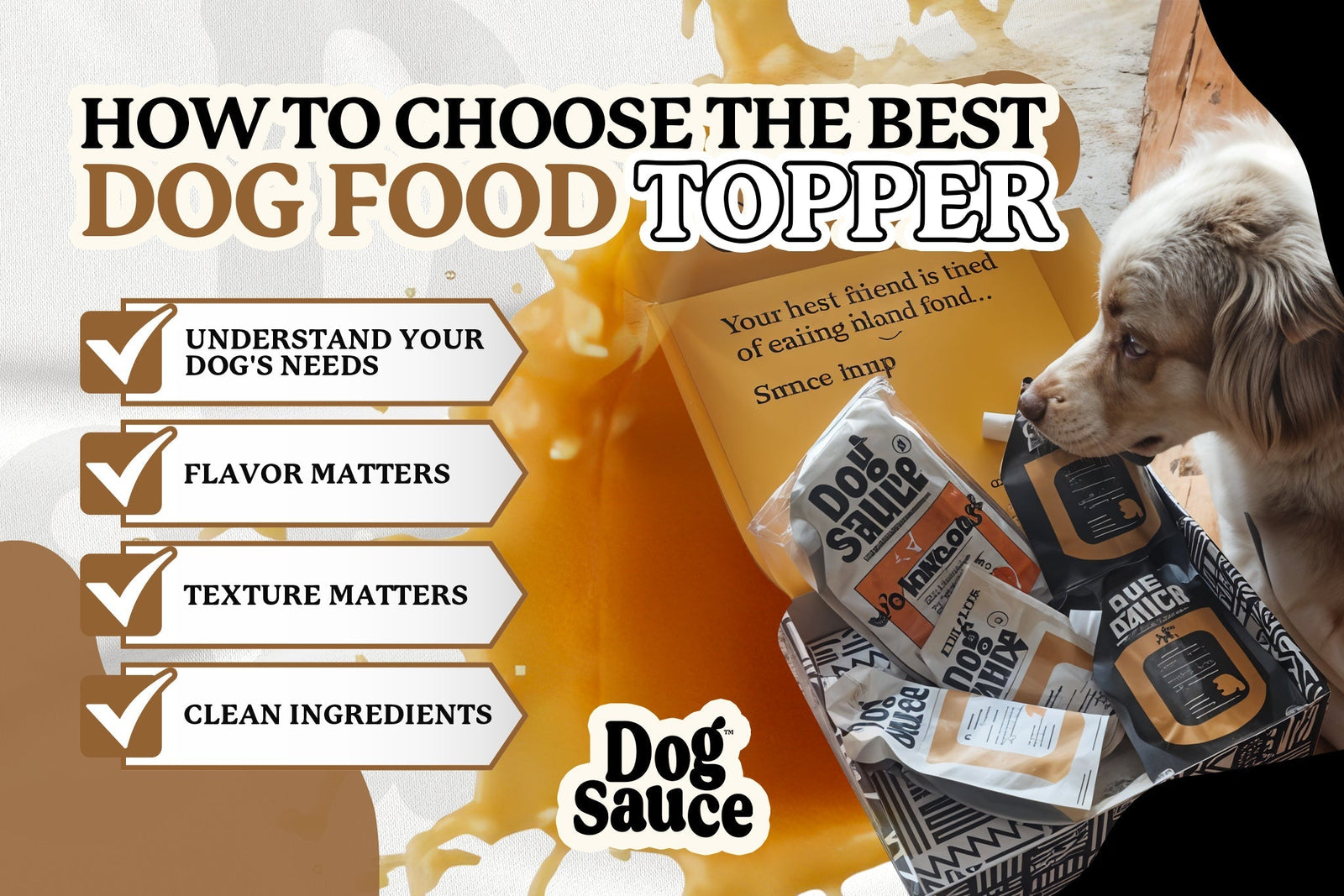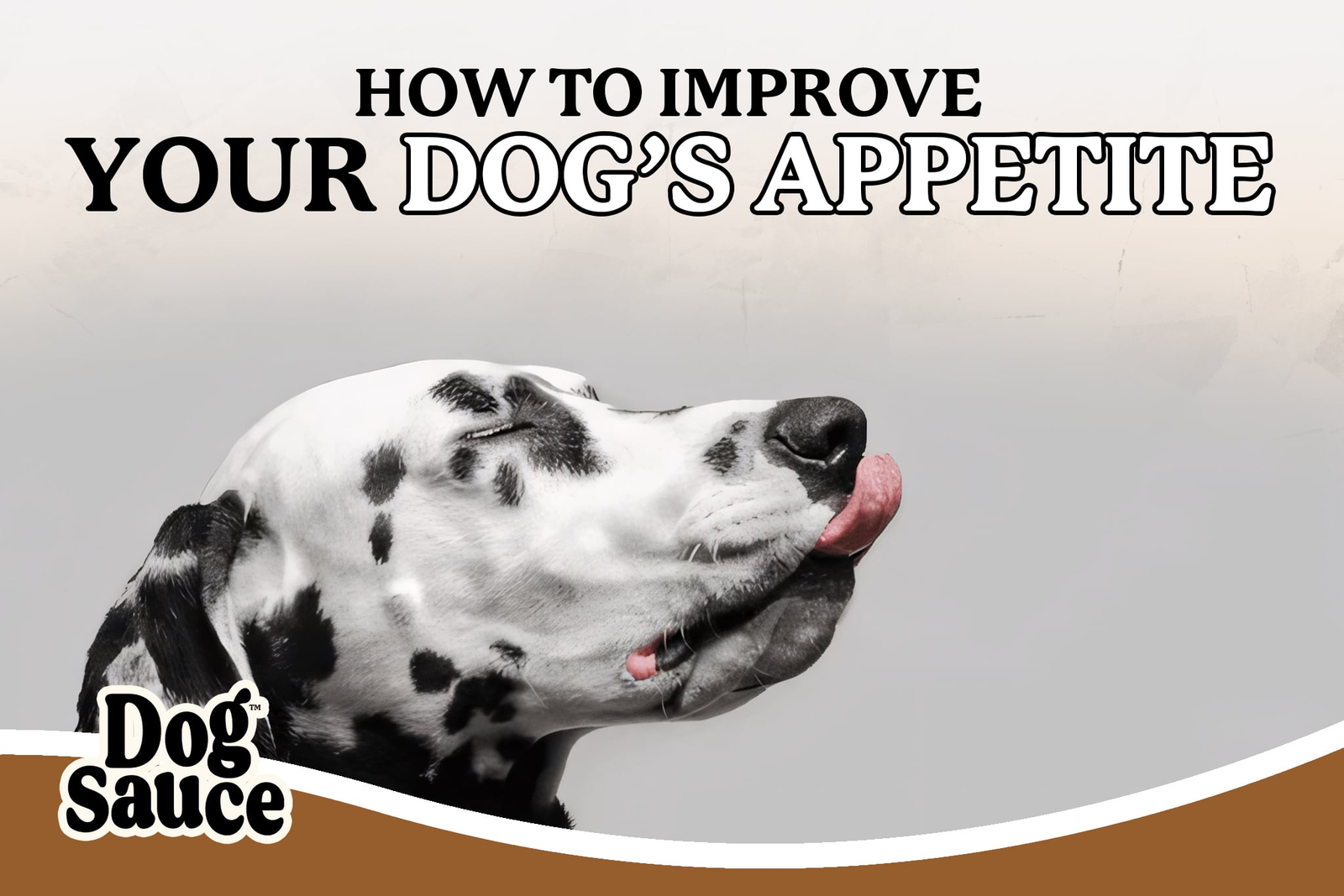🐶 Free shipping on order over $75
🐶 Free shipping on order over $75
Shop

The Ultimate Guide to Dog Nutrition
Feeding your dog isn’t just about filling their bowl; it’s about giving them the fuel they need to live a healthy, happy life. But with endless options on the market, from grain-free formulas to breed-specific blends, how can you be sure you’re making the right choice?
What does a truly balanced diet look like for a puppy versus a senior dog? And how do you know if your dog gets all the necessary nutrients?
In this guide, we’ll walk you through everything you need to know about dog nutrition. Whether you're a new pet parent or looking to level up your dog’s diet, you’ll learn how to make smarter, healthier feeding decisions tailored to your pup’s unique needs.
What Are the Essential Nutrients for Dogs?

Just like humans, dogs need a mix of essentials to be healthy. The AAFCO (Association of American Feed Control Officials) sets the balanced diet standards for commercial pet food.
These standards ensure your furry friend gets everything they need to thrive. According to AFFCO, your dog’s diet should have a mix of:
- Protein
- Fats
- Carbohydrates
- Vitamins
- Minerals
- Water
Together, these support everything from your dog’s muscles and coat to digestion and immune health. If your dog food label says “complete and balanced,” it means it checks all these boxes for your pup’s life stage (puppy, adult, or senior).
Let’s get into each in more detail:
Proteins
Proteins are your dog’s body's building blocks for muscle growth, tissue repair, and immune function.
Dogs need 22 amino acids, but their bodies only make 12. The other 10? They have to come from food.
High-quality protein sources include:
- Meat,
- Eggs
- Fish
- Turkey
In the right proportions, these will provide your dog all the essential amino acids.
The AAFCO recommends that adult dogs need at least 18% protein in their diet, growing puppies and pregnant or nursing dogs need at least 22.5%
If your dog doesn’t get enough protein, you might notice decreased appetite, poor growth, weight loss, a rough coat, or reduced immune function. So, ensuring enough protein is essential!
Fats
Fats are fuel. They provide 2.25 times more energy per gram than proteins or carbs for active dogs.
Fats support healthy skin and coat, body temperature, and internal organs. They also help absorb fat-soluble vitamins A, D, E, and K.
Your dog needs essential fatty acids that their bodies can’t produce naturally.
Omega-3 fatty acids (EPA and DHA) reduce inflammation and omega-6 fatty acids promote skin and coat health. Fish oil, chicken fat, and flaxseed are excellent sources.
The AAFCO minimum crude fat level for dogs is 5% for adults and 8% for puppies.
Carbohydrates
Dogs don’t need carbohydrates in their diet except during pregnancy and lactation. After all, they are carnivores in nature, right?
But here is the thing: carbohydrates are the primary source of glucose, fueling your dog’s brain and red blood cells.
Carbohydrates in dog food also provide structure to dry kibble and help with digestion.
They come from grains and plants and provide energy in the form of sugars.
Examples include:
- Brown rice
- Sweet potatoes
- Barley
- Oats
Studies show diets with 35-40% starch are over 99% digestible by dogs. Fiber (an indigestible carbohydrate) helps with weight management by making your dog feel full without adding many calories.
tarch are over 99% digestible by dogs. Fiber (an indigestible carbohydrate) helps with weight management by making your dog feel full without adding many calories.
Vitamins and Minerals
Dogs need vitamins A, D, E, K, and B complex for growth and maintenance.
Minerals like calcium and phosphorus make up bone matter, iron carries oxygen through the body, selenium is an antioxidant, and zinc is for wound healing.
Commercial dog food labeled “complete and balanced” has all the vitamins and minerals your dog needs. But if your four-legged friend is on a homemade diet, they may need supplements to ensure they get enough vitamins with their meals.
Water
Water may be the most underrated nutrient, but guess what? It is the most important. It makes up 70-80% of your dog’s body and is involved in literally everything in your dog’s bodily function, like:
- Water brings nutrients into and out of cells
- Regulates body temperature
- Lubricates joints,
- Cushions the brain and spinal cord.
Your dog should drink about 1 ounce of water per pound of body weight per day, more if it’s active, on a dry food diet, or if it’s hot outside.
So keep that water bowl clean and full!
To check for dehydration, pinch the skin between your dog’s shoulder blades—it should spring back quickly.
Dry gums, sunken eyeballs, and lethargy are other signs of dehydration that need attention immediately.
How to Choose the Right Dog Food
Picking dog food doesn’t have to be overwhelming. The key is finding one that’s high-quality, says “complete and balanced,” and fits your dog’s age and needs.
Understanding Dog Food Labels
The Association of American Feed Control Officials (AAFCO) sets nutrient profiles for complete diets. A label might even cite AAFCO. If a food meets AAFCO standards, it’s formulated to cover a dog’s nutritional needs at that life stage.
However, pet owners should still read the label: less desirable foods can hide behind fancy marketing.
- Look for named ingredients (like “chicken meal,” not “meat meal”)
- Make sure it says “complete and balanced” for your dog’s life stage
- Check the first five ingredients, that’s where most nutrients come from
As the VCA hospital notes, “Feed your dog the highest-quality food you can afford” because two foods with the same protein % can be very different based on ingredients.
If most ingredients sound like whole foods (meats, veggies, grains) rather than chemical names, that’s a good sign of quality.
For more details on reading labels, check out DogSauce’s guide on Understanding Dog Food Labels – it walks through label terms and common tricks. Always pick food with clear ingredients, a complete balance statement, and one suited for your dog’s needs (puppy, adult, or senior).
Considering Life Stage and Breed Size
Different dogs = different diets. Not all dogs eat alike. Here’s how to feed based on life stage and size:
- Puppies need more protein (min 22.5%) and calories to fuel growth
- Adults need a balanced diet for maintenance, with about 18% minimum protein
- Seniors: Added fiber, antioxidants, joint support, and moderate high-quality protein to maintain muscle mass while protecting kidneys.
Breed size tips:
- Large breeds: Watch calcium and phosphorus to protect joints
- Small breeds: Need calorie-dense food in small portions
Special Dietary Needs
Some dogs require special diets due to health conditions, allergies, or sensitivities. In these cases, consult your vet before choosing a special formula. They may recommend limited-ingredient diets, hypoallergenic formulas, or foods for specific health issues.
Older dogs often suffer from obesity and decreased gastrointestinal function and may benefit from lower-calorie, higher-fiber diets. Some senior formulas have added glucosamine and chondroitin for joint health.
Remember, the best way to know if a food works for your dog is to monitor them on it. A shiny coat, good energy, and good stool quality mean the food is good for your pet.
How Much Should I Feed My Dog Every Day?
Figuring out the right amount to feed depends on many factors, but the key is to match food to your dog’s energy needs and keep portions consistent. Start with the feeding chart on your dog food package, which suggests daily cups by weight. Then, adjust based on your dog’s individual needs.
The amount of food a dog needs is based on:
- Age: Puppies need more calories and protein for growth. Senior dogs usually need fewer calories.
- Size and Breed: Big dogs eat more than small dogs. A 5-lb Chihuahua won’t eat as much as a 50-lb Labrador!
- Activity Level: Active or working dogs burn more energy and may need more food. Couch potatoes need less to avoid weight gain.
- Spay/Neuter Status: Neutered dogs often have a slower metabolism and need fewer calories than intact dogs.
- Body Condition: Overweight dogs should eat fewer calories, while underweight dogs may need more. Your dog’s body condition score (BCS) is a great tool: it’s a 1–9 scale vets use to measure fat. Cut the food if your pup is a 7 or 8 (overweight); if they’re a 3 (too thin), add some.
Proper Portion Sizes and Feeding Frequency
Feeding your dog the right amount keeps them healthy and at a good weight, and it starts with these two things: how much and how often.
How Much to Feed
Start with the feeding chart on your dog food label—it’s a solid baseline.
You can also use this general rule:
Feed 2–3% of your dog’s body weight per day
Example: A 50-lb dog needs around 1 to 1.5 lbs of food daily
How Often to Feed
- Adult dogs: 2 meals per day (morning & evening)
- Puppies: 3–4 smaller meals a day, then shift to 2 as they grow
Stick to a consistent feeding schedule—exact times and the same portions. This helps with digestion, builds routine, and reduces begging or anxiety around food.
Do you need age-specific guidance? Our blog, Dog Feeding Schedule by Age, offers tailored plans from puppyhood to senior years.
Monitoring Your Dog’s Weight
Keeping an eye on your dog’s weight is vital. Check your dog’s body condition regularly – you should feel ribs with a slight fat cover and see a waist when looking from above. If you suspect extra pounds, weigh your dog or ask the vet at the next visit.
A body condition score (BCS) is a tool vets use (on a 1–9 scale) to rate fat – aim for a BCS of about 4–5 (ideal). Dogs with a BCS of 7 or higher are overweight.
Use your dog’s ideal weight as the feeding target.
What Are Common Dog Feeding Mistakes to Avoid?
Here are some pitfalls to watch out for when feeding your dog:
Overfeeding or Underfeeding
Interestingly, 54% of dogs in the US are overweight or obese, according to the Association for Pet Obesity Prevention (APOP). That’s how easy it is to give your fur baby more calories than it needs.
Signs of overfeeding:
- Visible weight gain without a waist
- Can’t feel ribs beneath a thick fat layer
- Reduced mobility and energy
- Increased risk of health problems like arthritis and heart disease
Underfeeding can be just as bad. An underfed dog will show thin fur, bald patches, low energy, and compromised immune function. If your dog is always hungry or scavenging around the house, they might not get enough nutrients.
Instead of guessing portions, use measuring cups for consistent amounts. Remember, the feeding guidelines on the package are just a starting point—your dog’s needs may be 25% more or less.
Feeding Inappropriate Human Foods
That cute face might make you want to share your meal, but some human foods are dangerous or fatal to dogs. Foods with xylitol (found in many sugar-free products) can cause hypoglycemia and liver damage. Chocolate contains methylxanthines that can cause vomiting, diarrhea, and even seizures.
Other harmful foods include:
- Grapes and raisins (can cause kidney failure)
- Onions, garlic, and chives (damage red blood cells)
- Alcohol (toxic even in small amounts)
- Avocados (contain persin, which is toxic to dogs)
Inconsistent Feeding Schedules
Dogs thrive on routine. Irregular meal times or amounts can stress them out and harm digestion. A set schedule – say every morning and evening – helps a dog’s system process food consistently. It also prevents begging or overeating during the day since dogs learn when to expect their next meal.
Dog Sauce’s feeding guide explains, “A consistent feeding routine is key to your dog’s health… It promotes good habits, aids digestion, and balances their energy.” So, try to feed at roughly the exact times every day and in consistent portions.
I’m Worried My Dog Isn’t Eating Enough — Is There a Solution?
Some dogs tend to be picky about their food for various reasons. Maybe it's texture, flavor, boredom, or even stress. If you're worried your pup isn't eating enough and not getting enough nutrients, don't panic.
One simple way to get them excited about food again is to add a tasty, nutritious topper like Dog Sauce to their meals. It's not just a meal topper; it also provides additional nutrients like omega-3 fatty acids, antioxidants, and enzymes that support digestion.
Sometimes, all it takes is a little extra love in the bowl!
FAQs:
What Is Proper Nutrition for a Dog?
A complete, balanced diet with the right amounts of protein, fat, carbs, vitamins, minerals, and clean water.
What Is the Healthiest Food to Feed Your Dog?
Food that meets AAFCO standards and lists real animal protein as the first ingredient—no fillers, no artificial junk.
What Is the 3 Rule on Dog Food?
Check the first 3 ingredients—they’re the most abundant. Look for named proteins and avoid foods loaded with fillers like corn or soy.
What Is the Most Common Nutritional Deficiency in Dogs?
Calcium is especially important in homemade diets. Vitamin D and fatty acids can also be low if they are not properly balanced.
How Much Protein Does My Dog Need?
Adult dogs need 18–25% protein; puppies and active dogs may need up to 30%. Check the label or ask your vet.
Can I Feed My Dog Homemade Food Instead of Dog Food?
Yes, you can feed your dog homemade food, but it must be properly balanced to ensure it gets all the nutrients it needs. Homemade diets should be planned with a veterinary nutritionist to avoid deficiencies or excesses, especially in calcium, phosphorus, and vitamins.
Do Dogs Need Vitamin Supplements?
Most healthy dogs eating a balanced commercial diet do not need additional vitamin supplements. However, dogs on homemade diets or those with specific health conditions may benefit from supplements a veterinarian recommends.
Related Products
Related Articles
How to Choose the Right Dog Food Topper for Your Pet
July 31, 2025
How to Improve Your Dog’s Appetite
July 22, 2025
How To Get a Picky Puppy to Eat
July 21, 2025
Subscribe
Sign up to get the latest on sales, new releases and more …
Free Shipping
Free shipping on orders over $75
Money‐Back
Money back guarantee if your dog doesn't like it
Secure Checkout
Fast and smooth payment processing
{"statementLink":"","footerHtml":"","hideMobile":false,"hideTrigger":false,"disableBgProcess":false,"language":"en","position":"left","leadColor":"#146ff8","triggerColor":"#146ff8","triggerRadius":"50%","triggerPositionX":"right","triggerPositionY":"bottom","triggerIcon":"people","triggerSize":"medium","triggerOffsetX":20,"triggerOffsetY":20,"mobile":{"triggerSize":"small","triggerPositionX":"right","triggerPositionY":"bottom","triggerOffsetX":10,"triggerOffsetY":10,"triggerRadius":"50%"}}







